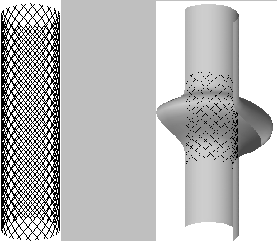
A sketch of a stent and of a stented aneurysm
<
Aneurysms and
Stents >
Aneurysm is characterized by the formation of sac-like protrusions of weakened sections of blood vessels that can rupture and be fatal. There is a 90% mortality rate associated with an out-of-hospital AAA rapture. Until recently, surgery has been the only treatment to prevent the aneurysm from rupturing. Since most of the patients are 55 or older and high risk, undergoing general anesthesia is not a solution.
Within the past ten
years an innovative non-invasive procedure, which requires only local
anesthesia, has been developed. The new procedure entails inserting a
catheter (a hollow tube) into an artery and directing it to the site of
the aneurysm. Placed in the catheter is a spring-like device called a
stent, see Figure 1, which serves to
hold open the weakened artery and to exclude the aneurysm from
circulation. This lowers the probability of rupture and promotes
aneurysm shrinking due to thrombosis caused by the lack of blood supply
to the aneurysm tissue.

The movies below show the pulsation of the stented abdominal aorta (without the aneurysmal pouch) over one cardiac cycle. Also shown is the radius change axial and circumferrential strain and the transmurral pressure.
Length of the vessel
shown: 10cm (0.1m)
Stent anchoring sites: x = 0.015m (proximal) x = 0.085m (distal)
Collaborators:
Dr. Zvonimir Krajcer, MD. F.A.C.C. Interventional Cardiologist Clinical Associate Professor in Medicine Baylor College of Medicine and the University of Texas Health Science Center Texas Heart Institute & St. Luke's Episcopal Hospital
Dr. K. Ravi-Chandar, Professor University of Texas in Austin Center for Mechanics of Solids, Structures and Materials